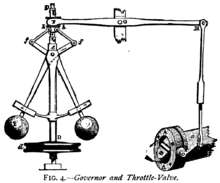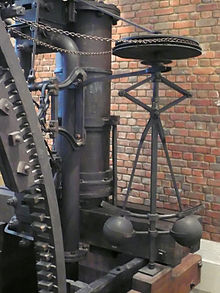- Centrifugal governor
-
A centrifugal governor is a specific type of governor that controls the speed of an engine by regulating the amount of fuel (or working fluid) admitted, so as to maintain a near constant speed whatever the load or fuel supply conditions. It uses the principle of proportional control.
It is most obviously seen on steam engines where it regulates the admission of steam into the cylinder(s). It is also found on internal combustion engines and variously fueled turbines, and in some modern striking clocks.
Contents
Operation
The device shown is from a steam engine. Power is supplied to the governor from the engine's output shaft by (in this instance) a belt or chain (not shown) connected to the lower belt wheel. The governor is connected to a throttle valve that regulates the flow of working fluid (steam) supplying the prime mover (prime mover not shown). As the speed of the prime mover increases, the central spindle of the governor rotates at a faster rate and the kinetic energy of the balls increases. This allows the two masses on lever arms to move outwards and upwards against gravity. If the motion goes far enough, this motion causes the lever arms to pull down on a thrust bearing, which moves a beam linkage, which reduces the aperture of a throttle valve. The rate of working-fluid entering the cylinder is thus reduced and the speed of the prime mover is controlled, preventing over-speeding.
Mechanical stops may be used to limit the range of throttle motion, as seen near the masses in the image at right.
The direction of the lever arm holding the mass will be along the vector sum of the reactive centrifugal force vector and the gravitational force.
History
James Watt designed his first governor in 1788 following a suggestion from his business partner Matthew Boulton. It was a conical pendulum governor and one of the final series of innovations Watt had employed for steam engines. James Watt never claimed the centrifugal governor to be an invention of his own. Centrifugal governors were used to regulate the distance and pressure between millstones in windmills since the 17th century. It is therefore a misunderstanding that James Watt is the inventor of this device.[1]
A giant statue of Watt's governor stands at Smethwick in the English West Midlands. It is known as the flyball governor.
Another kind of centrifugal governor consists of a pair of masses on a spindle inside a cylinder, the masses or the cylinder being coated with pads, somewhat like a drum brake. This is used in a spring-loaded record player and a spring-loaded telephone dial to limit the speed.
Dynamic systems
The centrifugal governor is often used in the cognitive sciences as an example of a dynamic system, in which the representation of information cannot be clearly separated from the operations being applied to the representation. And because the governor is a servomechanism, its analysis in a dynamic system is far from trivial. In 1868 James Clerk Maxwell wrote a famous paper "On governors"[2] that is widely considered a classic in feedback control theory. Maxwell distinguishes moderators (a centrifugal brake) and governors which control motive power input. He considers devices by James Watt, Professor James Thomson, Fleeming Jenkin, William Thomson, Leon Foucault and Carl Wilhelm Siemens (a liquid governor).
In a largely overlooked passage from his famous 1858 paper to the Linnean Society (which led Darwin to publish On the Origin of Species) Alfred Russel Wallace says of the evolutionary principle:
The action of this principle is exactly like that of the centrifugal governor of the steam engine, which checks and corrects any irregularities almost before they become evident; and in like manner no unbalanced deficiency in the animal kingdom can ever reach any conspicuous magnitude, because it would make itself felt at the very first step, by rendering existence difficult and extinction almost sure soon to follow.[3]
The cybernetician and anthropologist Gregory Bateson would observe in the 1970s that though seeing it only as an illustration, Wallace had "probably said the most powerful thing that’d been said in the 19th century". [4] Bateson revisited the topic in his 1979 book Mind and Nature: A Necessary Unity, and other scholars have continued to explore the connection between natural selection and systems theory.[5]
See also
References
- ^ Hills (1996), Power From the Wind, Cambridge University Press
- ^ Maxwell, James Clerk (1868). On Governors. 16. Proceedings of the Royal Society of London. pp. 270–283. http://en.wikipedia.org/wiki/File:On_Governors.pdf.
- ^ Wallace, Alfred Russell. "On the Tendency of Varieties to Depart Indefinitely From the Original Type". http://www.wku.edu/~smithch/wallace/S043.htm. Retrieved 2009-04-18.
- ^ Brand, Stewart. "For God’s Sake, Margaret". CoEvolutionary Quarterly, June 1976. Archived from the original on 2010-11-11. http://www.webcitation.org/5uA5NbNiG. Retrieved 2010-11-11.
- ^ Smith, Charles H.. "Wallace's Unfinished Business". Complexity (publisher Wiley Periodicals, Inc.) Volume 10, No 2, 2004. http://www.wku.edu/~smithch/essays/UNFIN.htm. Retrieved 2007-05-11.
Categories:- Mechanisms
- Control devices
- Cybernetics
- Mechanical power control
- Rotating machines
- Scottish inventions
- British inventions
Wikimedia Foundation. 2010.


